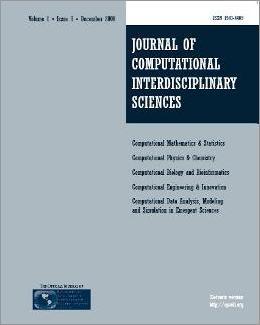
Editorial Office:
Management:
R. S. Oyarzabal
Technical Support:
D. H. Diaz
M. A. Gomez
W. Abrahão
G. Oliveira
Publisher by Knobook Pub


Editorial Office:
Management:
R. S. Oyarzabal
Technical Support:
D. H. Diaz
M. A. Gomez
W. Abrahão
G. Oliveira
Publisher by Knobook Pub
doi: 10.6062/jcis.2012.03.02.0056(Free PDF)
Baumgarten W. and Hauser M. J. B.
Transportation networks are of paramount importance in natural and man-made systems. We present algorithms to extract two- dimensional real world networks from images, thus making the networks available for in silico analysis. The algorithms deal with image processing, network extraction, and correction of reconstruction errors. Next, methods are presented to obtain the geometrical and topological structure of the network. This yields the graph underlying the network, which can be subjected to graph theoretical analysis. The statistical distributions of the lengths, widths, and areas of the vein segments, as well as the angles between veins departing from a branching point are investigated. In a case study, the algorithms are applied to the tubular vein network of the myxomycete Physarum polycephalum. Despite of the large variability between different network realizations, statistics obtained from cummulated experiments correspond to those extracted from individual experiments.
Real network, Physarum polycephalum, venation, data extraction.
1] BARABASI AL, JEONG H, NEDA Z, RAVASZ E, SCHUBERT A & VICSEK T. 2002. Evolution of the social network of scientific collaborations. Physica A, 311: 590-614.
[2] FAGIOLO G, REYES J & SCHIAVO S. 2009. World-trade web: Topological properties, dynamics, and evolution. Phys. Rev. E, 79:036115.
[3] BARRAT A, BARTHELEMY M, PASTOR-SATORRAS R & VES-PIGNANI A. 2004. The architecture of complex weighted networks.Proc. Natl. Acad. Sci., USA, 101: 3747-3752.
[4] GUIMERA R, MOSSA S, TURTSCHI A & AMARAL LAN. 2005.The worldwide air transportation network: Anomalous centrality,community structure, and cities’ global roles. Proc. Natl. Acad. Sci.,USA, 102: 7794-7799.
[5] LI W & CAI X. 2007. Empirical analysis of a scale-free railway network in China. Physica A, 382: 693-703.
[6] DOMENECH A. 2009. A topological phase transition between small-world and fractal scaling in urban railway transportation networks? Physica A, 388: 4658-4668.
[7] WATTS DJ & STROGATZ SH. 1998. Collective dynamics of ‘smallworld’ networks. Nature, 393: 440-442.
[8] BUHL J, GAUTRAIS J, SOLE RV, KUNTZ P, VALVERDE S, DENEUBOURG JL & THERAULAZ G. 2004. Efficiency and robustness in ant networks of galleries. Eur. Phys. J. B, 42: 123-129.
[9] BUHL J, GAUTRAIS J, DENEUBOURG JL & THERAULAZ G. 2004. Nest excavation in ants: group size effects on the size and structure of tunneling networks. Naturwiss., 91: 602-606.
[10] BUHL J, GAUTRAIS J, DENEUBOURG JL, KUNTZ P & THER-AULAZ G. 2006. The growth and form of tunneling networks in ants. J. Theor. Biol., 243: 287-298.
[11] GAZIT Y, BERK DA, LEUNIG M, BAXTER LT & JAIN RK. 1995. Scale-invariant behaivor and vascular network formation in normal and tumor tissue. Phys. Rev. Lett., 75: 12, 2428.
[12] BOHN S, ANDREOTTI B, DOUADY S, MUNZINGER J & COUDER Y. 2002. Constitutive property of the local organization of leaf venation networks. Phys. Rev. E, 65: 1-12.
[13] KATIFORI E, SZOLLOSI GJ & MAGNASCO MO. 2010. Damage and fluctuations induce loops in optimal transport networks. Phys. Rev. Lett., 104: 1-4.
[14] UEDA T. 2005. An inteligent slime mold: A self-organizing system of cell shape and information. In: ARMBRUSTER D, KANEKO K & MIKHAILOV AS (Eds.) Networks of interacting machines. World Scientific, New Jersey, pp. 221-255.
[15] BAUMGARTEN W, UEDA T & HAUSER MJB. 2010. Plasmodial vein networks of the slime mold Physarum polycephalum form regular graphs. Phys. Rev. E, 82: 046113.
[16] TERO A, TAKAGI S, SAIGUSA T, ITO K, BEBBER DP, FRICKER MD, YUMIKI K, KOBAYASHI R & NAKAGAKI T. 2010. Rules for biologically inspired adaptive network design. Science 327: 439-442.
[17] NAKAGAKI T, KOBAYASHI R, NISHIURA Y & UEDA T. 2004. Obtaining multiple separated food sources: Behavioural intelligence in Physarum polycephalum. Proc. R. Soc. Lond. B, 271: 2305-2310.
[18] NAKAGAKI T, IIMA M, UEDA T, NISHIURA Y, SAIGUSA T, TERO A, KOBAYASHI R & SHOWALTER K. 2007. Minimum-risk path finding by an adaptive amoebal network. Phys. Rev. Lett., 99: 068104.
[19] WATANABE S, TERO A, TAKAMATSU A & NAKAGAKI T. 2011. Traffic optimization in railroad networks using an algorithm mimicking an amoeba-like organism, Physarum plasmodium. BioSystems, 105: 225-232.
[20] BAUMGARTEN W & HAUSER MJB. 2010. Detection, extraction,and analysis of the vein network of the slime mould Physarum polycephalum. J. Comp. Interdisc. Sci., 1: 241-249.
[21] ZHANG T & SUEN C. 1984. A fast parallel algorithm for thinning digital patterns. Comm. ACM, 27: 236-239.
[22] ITO M, OKAMOTO R & TAKAMATSU A. 2011. Characterization of adaptation by morphology in a planar biological network of plasmodial slime mold. J. Phys. Soc. Japan, 80: 074801.